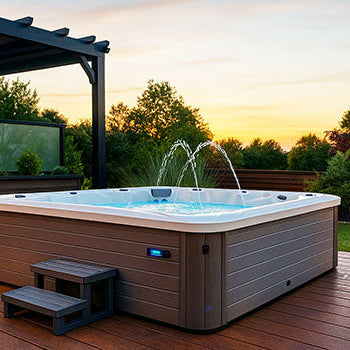Yes, hot tubs are heavy. like “do n’t-try-this-alone” heavy. Even without water, they bring serious weight to the party thanks to their solid shells and frames. From inflatable styles to rugged wooden spas, the range is impressive. Acrylic Hot Tubs and Rotomoulded Hot Tubs? Lighter, but still not featherlight. Wooden Hot Tubs? They're like lifting a soaked oak barrel.
Short answer: Hot tubs are heavy due to their size, structure, and how much water they hold. Curious how that impacts installation or your deck's strength? Keep reading before your backyard plans go sideways.

How Much Does a Hot Tub Typically Weigh?
Empty Weight (Dry Weight) Ranges by Size and Type
Let’s start dry. A hot tub straight out of the showroom can still weigh more than a motorcycle. Here’s what to expect:
Acrylic models usually fall in the 350–450 kg range. Wooden ones? Even heavier, think 500–700 kg.
Rotomoulded tubs, though lighter, still pack a punch at around 250–350 kg.
The Weight of Water: Calculating Filled Weight
Water adds serious bulk. With 1 litre weighing roughly 1 kg, filling a tub means you’re adding hundreds of extra kilos.
Let’s say:
That’s 1,500 kg total weight, roughly the weight of a small car!
Total Weight Examples (Small, Medium, Large Tubs)
To make things crystal clear:
-
Small tub: 250 kg dry + 900 litres = ~1,150 kg
-
Medium tub: 350 kg dry + 1,200 litres = ~1,550 kg
-
Large tub: 500 kg dry + 1,500 litres = ~2,000 kg
That’s a whole lot of weight sitting on your patio.
Why Does Hot Tub Weight Matter?
The Importance of a Proper Foundation
This isn’t just a garden upgrade, it’s a structural commitment. Without proper support, your hot tub could sink, tilt, or crack. A solid, flat foundation spreads the load and protects both the tub and your outdoor space.
Structural Considerations for Decks and Balconies
Thinking about placing it on your deck or balcony? Hit pause. Filled tubs can easily push over 300 kg per square metre, which most decks aren't built to handle without extra reinforcement. You’ll want to double-check that frame.
Delivery and Installation Challenges
Heavy tubs mean heavy lifting. Moving one could require a team, a dolly, or even a crane. Tight corners, soft soil, or narrow paths? These can complicate delivery and crank up your costs.
Moving an Existing Hot Tub
Relocating a spa isn’t just about draining it and pushing it across the yard. Even empty, Wooden Hot Tubs can be a beast to shift. Professionals often bring lifting gear, sliders, and a crew to move things safely.

Foundation Requirements: What Can Support a Heavy Hot Tub?
Concrete Slabs: The Gold Standard
Ask any pro and they’ll tell you: a reinforced concrete base is the safest bet. It’s strong, flat, weather-resistant, and built to last. Once it’s in, it rarely needs adjusting.
Paver Bases: A Viable Alternative
Want a more budget-friendly or DIY option? Interlocking pavers can work, but only if laid on a well-compacted and level base. If they shift or sink, so will your tub.
Reinforced Wooden Decks: Assessing Load Capacity
Yes, you can place a hot tub on a wooden deck, but it must be reinforced. That means extra joists, stronger beams, and sometimes steel supports. Don’t guess, check your specs.
Pre-Fabricated Spa Pads
These are growing in popularity for quick installs. Made of heavy-duty plastic or rubber, spa pads offer a sturdy base, but only when installed on flat, compacted ground.
Why Grass or Bare Earth Isn’t Suitable
Hot tubs and nature don’t mix well here. Never place your spa directly on grass, dirt, or gravel. Moisture, uneven settling, and sinking are real risks, plus it can ruin your tub’s underside.
Can My Deck Hold a Hot Tub? How to Check
Understanding Deck Load Ratings
Every deck has a load limit, usually measured in kg per square metre. You’ll need to know if your deck can handle the weight of the hot tub + water + people. Spoiler: most can’t without some upgrades.
Calculating the Load Per Square Foot/Metre
Here’s how to check:
-
Work out your hot tub’s total filled weight
-
Divide that by the area it covers (in m² or ft²)
-
Compare that figure with your deck’s structural rating
If it’s too close for comfort, it’s time to call an expert.
Consulting a Structural Engineer
Still unsure? Call in a structural engineer. It’s a small cost now that could save you thousands later. They’ll tell you what reinforcements you need (if any) before you take the plunge.
Weight Considerations for Different Hot Tub Types
Inflatable Hot Tub Weight (Empty and Filled)
These are the lightweights of the spa world. Empty, they weigh as little as 25–50 kg. Even filled, you’re looking at 800–1,200 kg. Ideal for renters or anyone who wants a temporary soak.
Acrylic Hot Tub Weight Variations
Acrylic Hot Tubs bring the spa experience with durability and style. They weigh around 350–450 kg dry and up to 2,000 kg filled. Built for the long haul, but they need a solid base.
Rotomoulded Hot Tub Weight
Rotomoulded Hot Tubs are made from a single moulded plastic shell. That makes them light enough to move more easily, typically 250–350 kg empty. Great for families, rentals, or smaller outdoor spaces.

Conclusion: Planning for Hot Tub Weight in Your Installation
Here’s the bottom line: weight matters more than you think when it comes to hot tubs. It influences everything, where it sits, what supports it, how you move it, and how much it’ll cost to set up.
Choosing between a compact acrylic, a portable rotomoulded model, or a luxurious wooden spa? That choice comes with weight implications. Be sure to prep your base properly, check your structure’s strength, and don’t hesitate to get expert advice.
A little planning now means a lot more soaking later, with zero surprises beneath your feet.










